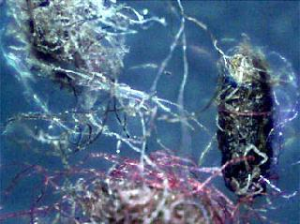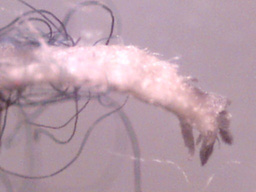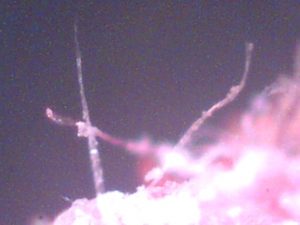Table of Contents
Morgellon’s Disease
I’m still fielding calls from potential clients and other practitioners for a very strange set of symptoms. There’s a new disease out there that a 12-person task force at the Center for Disease Control has. Not much is coming from this task force. It was brought to their attention by the public, health care providers, public health officials, Congress and the media. So far, results have been inconclusive. It’s called Morgellon’s Disease.
As of October 29, 2008, 13,024 families have registered with the Morgellons Research Foundation (MRF) (Reference: https://www.morgellons.org) and felt they or a member of their family met criteria for Morgellons as defined by the MRF. Of the U.S. families in the MRF registry, 24% reside in California with geographic clustering in the San Francisco metropolitan areas. I’m fielding cases from all over the United States though.
A 63—year-old African American woman who was the sole bread winner and matriarch of her family was walking down a big city street in the southern Midwest near an Asian restaurant one day and a bug flew up her nose.
Well, a couple of weeks after that, she felt itching—like parasites were crawling on her skin and hair. Eventually she could see little bugs crawling out of her skin. The itching increased in intensity to encompass 24-hours a day and she could barely get any rest. She called in a local exterminator twice and had the house poisoned but the parasites only continued to grow inside her. She took herbs, supplements and applied several things topically to no avail.
Trip after trip to several doctors who found nothing finally landed her in a mental institution. The only way she got out, she shared with me, was to tell people that she no longer saw the bugs and no longer itched. “It took all I had to keep from scratching just to get myself out of there” she said. “But I still itch.” (I’ve heard some people seeing up to 20 different doctors for Morgellons.)
She sent me samples which she had picked off her skin, scalp and coat in a 7-compartment pill box but when I looked at them all I saw were some balls of lint. Imagine my surprise when I put a specimen under the microscope and saw the typical Morgellon’s fibers! They looked pretty much like this:
I was really jazzed on finding out what this actually was, so I did some research and footwork and came up with the Morgellon’s possibility.
At first I forwarded these types of cases to the Center for Disease Control, mycologists, parasitologists, entomologists and to their local health departments but they shared with me that no one was willing to help them. As of 2017 the CDC has indeed confirmed Morgellon’s as a disease.
How hard could this be to get people excited about the possibility of discovering a new disease and learning more about it I thought—so I spent a day following leads:
I started in the veterinary department at Washington State University. They sent me to the parasitology department, who sent me to the entomology department. It was here where I got the most information.
Apparently the entomologists have been seeing the most cases of this Morgellon’s syndrome. They’ve spend a lot of time as a group trying to help people with this disease and even speak about it at their conventions. The conclusion (much to the relief of the entomologist I talked to for about an hour) was that they should send these people back to their doctors, that they can’t do anything about it and are wasting their time, that some people actually DO have parasites on their bodies (this entomologist found a cockroach egg in the samples I brought to him which I almost had to force on him to take a look at under his microscope). He did share with me that there was a medical doctor who had received a grant to study this disease but he couldn’t remember her name. Upon hours of additional research, I think he was talking about the grant given to Kaiser Permanente (Reference: https://www.naturalnews.com/023004.html ).
I left him my card and he said he’d get back to me. He didn’t. Apparently people are just too busy to get sucked into the volumes of time it would take to figure this thing out. Very discouraging. If any of my readers know a resource for this person studying the disease, please let me know and I’ll post it here.
History of Morgellon’s Disease:
The Center for Disease Control has been receiving as many as 20 calls/day from self-diagnosed Morgellon’s patients for some time now. Morgellon’s (pronounced more-GELL-uns) was named in 2001 by a Morgellons biologist, Mary Leitao. A South Carolina woman whose son suffers from the condition, Mary had researched the symptoms her son had and ferreted out a French medical paper written on a disease they called Morgellons in 1674 describing similar symptoms so began using that name. The name stuck.
Mary founded the Morgellons Research Foundation (https://www.morgellons.org ) which is now known as a leading source of information and research advocacy.
The challenge these poor people are having is that, since it is not an official disease written up in the medical texts, the practitioners out in the field are treating these types of cases like the patient has delusional parasitosis—with antidepressants and antipsychotic drugs.
Delusional Parasitosis (DP) is a psychosis in which sufferers believe they are infected with parasites. Patients may present with clothing lint, pieces of skin, or other debris contained in plastic wrap, on adhesive tape or in matchboxes (this is called the matchbox or Saran-wrap sign). They typically state that these contain the parasites, but none can be identified upon microscopic inspection.
Patients have no obvious mental impairments and primary skin lesions are not present although they may have linear crusts, erosions, prurigo nodularis (large nodules that itch) or ulcers. Delusional parasitosis has been associated with schizophrenia, obsessive compulsive disease, bipolar disorder, depression and anxiety disorders and DP occurs primarily in white middle-aged or older women although it has been reported in all age groups and in men.
Often the patient has a real-life problem with scabies, lice, or some other external parasite. They imagine they are continually being attacked even after the parasite has been treated and the area fumigated. This delusion can be shared with family members having the same symptoms.
The use of Dabbing (taking in concentrated TCH which has been refined with butane) can also cause this creepy feeling under the skin (allergic reaction to butane?) https://www.centeronaddiction.org/the-buzz-blog/dabbing-what-you-need-know-about-latest-marijuana-craze
I’ll admit, after and hour on the phone with one person sharing her history I was having a difficult time not wondering about the other rule outs such as drugs, schizophrenia and psychosis! I had one woman call that had similar signs to Morgellon’s but upon getting a more detailed history she also had an alien encounter.
I referred her to MUFON (Mutual UFO Network: https://www.mufon.com/ ) because in addition to typical Morgellons symptoms, she had a boil behind her ear which can sometimes be associated with an alien implant (something I’m not qualified to handle in my practice).
So, back to Morgellons. . .Although Morgellon’s has not been proven to be fatal, it can drive one to suicide I suppose. It has been known to go into spontaneous remission.
Here’s a list of symptoms associated with Morgellons (in alphabetical order):
- Brain fog
- Changes in vision
- Chronic fatigue syndrome (CFS)
- Concentration problems
- Crawling sensations along the skin
- Elevated cytokines, TNF-alpha and IL-6
- Elevated fasting glucose and insulin levels
- Fatigue
- Fever
- Fiber-like, filamentous substance penetrating through or under the skin (often red and blue) that also migrate, erupt and stick out of the skin (see more on fiber description below.)
- Fibromyalgia
- Irregular bowel movements
- Joint pain
- Madness—thoughts of ending it all because the itching doesn’t ever stop
- Malaise
- Measurable memory deficits
- Mental confusion
- Non-healing skin lesions associated with highly unusual structures
- Seed-like, black speck-like material or little black dots on the skin
- Sensation of fluid moving under the skin
- Short term memory loss
- Skin crawling, stinging, biting sensation
- Skin may be intact and healthy looking
- Skin rash
- Sleep problems
- Sores on the body (lips, arms and legs are common)
- Tachycardia (heart rate speeding up)
- Tiny dark specks on the skin and in the house
- Weakened immune system
One doesn’t need to have all these symptoms to have Morgellons and I’ve used the wording that I found in my research so some of the symptoms are the same. And many of these symptoms are associated with a myriad of other diseases of course—except those fibers. . .
Morgellons fibers have been evaluated by forensic labs and do not match up to carpet, clothing or other synthetic fibers. They have been described as elongated coenocytic (aseptate), smooth-walled, branching fibers like this:
Or granules, threads or filamentous objects up to several millimeters long often seen as zig zag patterns or twisted into balls or what appear to be bundles of fibers growing within the skin. These fibers can be extremely sharp, even penetrating the nails. They can be as fine as spider silk, yet strong enough to distend the skin when you pull them.
They do not fit into the same category as a fungus. The fibers are most often white but are also consistently seen as blue, black and rarely red. The fibers exhibit a high degree of autofluorescence and are not textile fibers like this picture.
Here is a picture of Morgellons fibers taken from a child’s lip skin.
Treatments Tried for Morgellons Disease:
People are desperate to stop the itch of this disease and have tried so many things. Some of them work initially (placebo effect?) and then stop working. Other treatments include toxic and potentially dangerous use of products including strong insecticides. Some of these treatments have included:
- Borax soaks
- Antibiotics of all kinds (esp. those used in the treatment of Lyme disease)
- Herbs
- Industrial bug killers
- Medications of all kinds that kill parasites
One woman I talked to slathered her entire body in some type of natural toothpaste which she said worked for a few hours. She was discouraged that her local health food store only carried eight tubes of it though and it was expensive. Now this is desperate thinking!
Theories on the cause of Morgellons Disease:
- Fungal origin: Researcher Ahmed Kilani says he was able to break down two fiber and extract their DNA and that he found the DNA belonged to a fungus. (Reference: https://www.naturalnews.com/023004.html )
- Bacterial cause: Some researchers think Morgellons could be caused by a bacteria although the fibers are more consistent with a fungal infection.
- Pollutants: Possibly human hair follicles are somehow encapsulated with pollutants processed by the body.
- Genetically Modified Organisms: There have been many articles written about this theory. An article written by Whitley Strieber, “Skin Disease May Be Linked to GM Food’ is flying around the internet these days. I can’t locate that original reference for you.
- One biochemist, Vitaly Citovsky, discovered a substance called Agrobacterium, which is commercially used to produce genetically modified plants. (Reference: https://morgellonswatch.com/2007/02/24/clarification-from-vitaly-citovsky ) The Centers for Disease Control (CDC) has given care giant Kaiser Permanente over $300,000 to test and interview 150 to 500 patients suffering from Morgellons Disease. The study will be done in northern California where many Morgellons patients live.
- Pesticides, chemicals or food additives are combining with human DNA to change or produce the protein, connective tissue or subcutaneous tissues in the body to make these fibers. There are now cases of Morgellons in all 50 of the United States and it is also being found in other countries. There seems to be a pool of cases in Southern California, Texas and Florida and this is one reason this theory persists. These are states that produce huge amounts of edible produce and who use lots of chemicals in that process.
- Disease of the mind: I don’t buy into this theory that Morgellons disease is all in people’s heads. I don’t believe it’s simply psychological.
- My own theory is that GMO soy or Splenda could be the culprit. I believe in the Occam’s Razor Principle that states, “All other things being equal, the simplest solution is the best.”
I even went so far as to have a homeopathic made that will take out Splenda from the body. I’m ready for the next case. I have questions I need to have answered though.
For example, I wonder if those people affected have connective tissue that easily responds to perms. I wonder if some of the connective tissue sulfur bonds are combining with something in the diet then eventually the body fibers act like a perm and spring. Is this the reason why these fibers pop out of the skin then dive back under as you grab at them?
So many of these cases involve little babies. How do they get something as awful as this at such a young age without having a common connection? What are these kids eating? Are they on soy-based formulas? Have they been to the doctor and been prescribed electrolyte solutions that contain Splenda? What are their diets?
And why does Morgellon’s seem to be prevalent in some professions? One client told me that all the nurses on her floor seem to be getting it. Is it something they eat in the break room? Or the fluids they drink? This is one of the reasons I researched out the list of foods containing Splenda. I was floored to find that so many infant foods contained that food additive, but they also contain soy.
We need more information here to make connections. We need people to keep detailed diaries of what they are eating along with brand names and amounts. If there is a food additive connection, we can find it with this information.
Updates:
“Hi Dr. Moffat, I was browsing your website for some info/treatment re: chronic pinworms when I came across your Morgellons section. Here is an update: Morgellons is a Lyme disease co-infection. It is transmitted, along with borrelia, after a tick bite, spider, lice or virtually any biting insect. It rarely, if ever, exists apart from a Lyme infection. Morgellons specimens contain plant DNA—so it is likely a fungus that an insect picks up while feeding on the white footed mouse, deer or anything else that can pass along borrelia.
“The fibers contain keratin from humans, so this “fungus” is manipulating cells to produce some kind of weird by-product. If you treat Lyme disease, babesia, bartonella etc. Morgellons—just as the other co-infections—responds in kind. So minocycline, Bactrim and Tinadazole are particularly good for this co-infection. If your readers want more info—please see the Charles E. Holman Foundation for the latest scientific research in this field. Foremost Lyme docs such as Horowitz, Jemsek, Ross address Morgellons in their treatment plans and literature. All the best, Kim McDonald”
Links and References for Morgellon’s Disease:
- Morgellon’s and the link with GMO foods. https://www.globalresearch.ca/gmo-and-morgellons-disease/8464
- Splenda: https://naturalhealthtechniques.com/splenda-sucralose/
- Splenda Containing Foods: https://naturalhealthtechniques.com/list-of-splenda-containing-foods/
- https://en.wikipedia.org/wiki/Morgellons#_note-CDC_Probes


